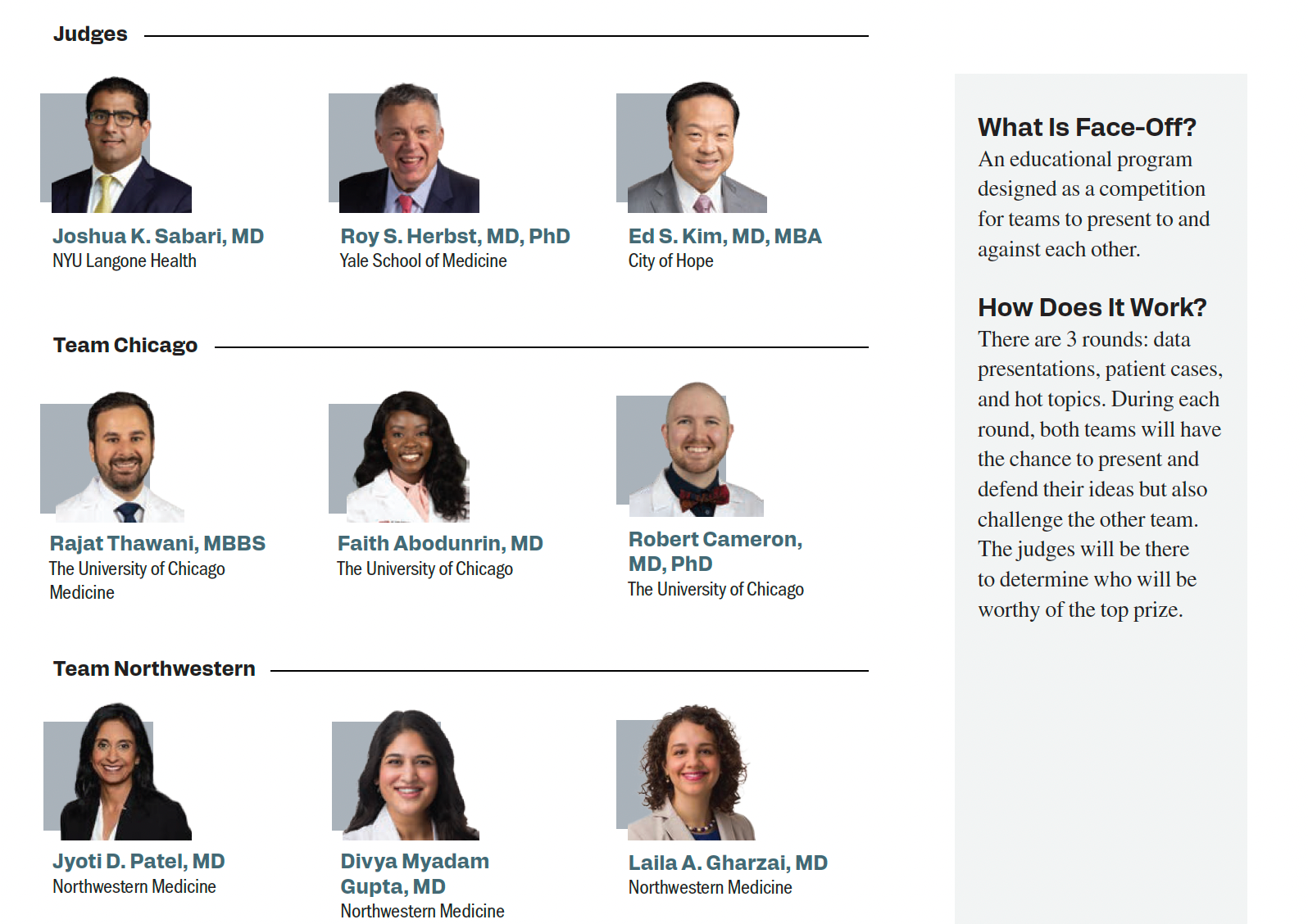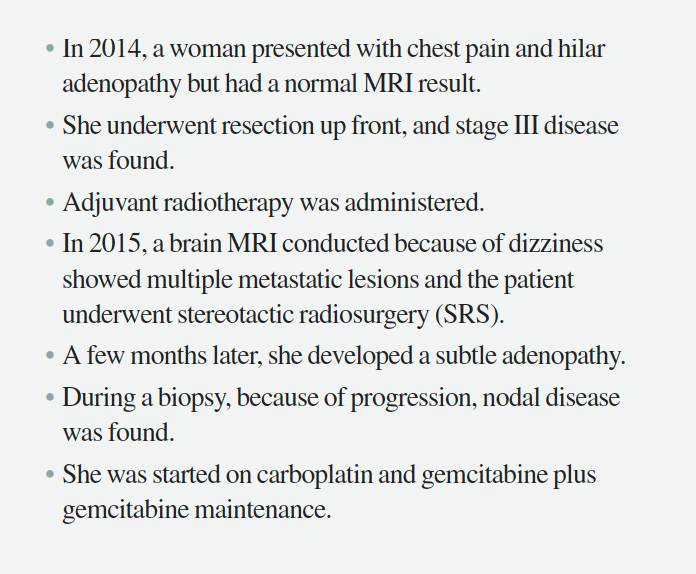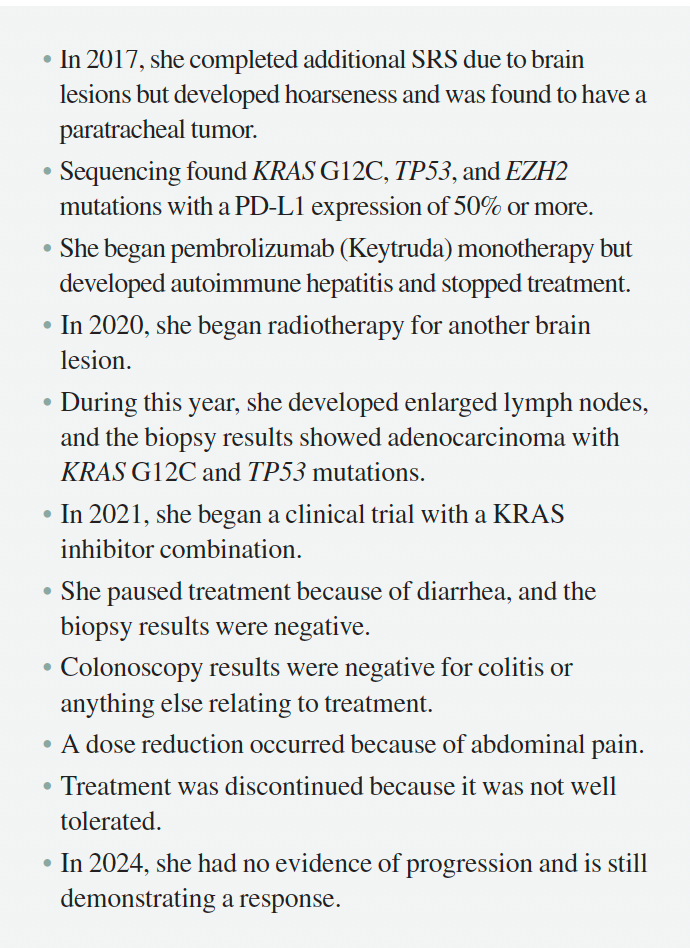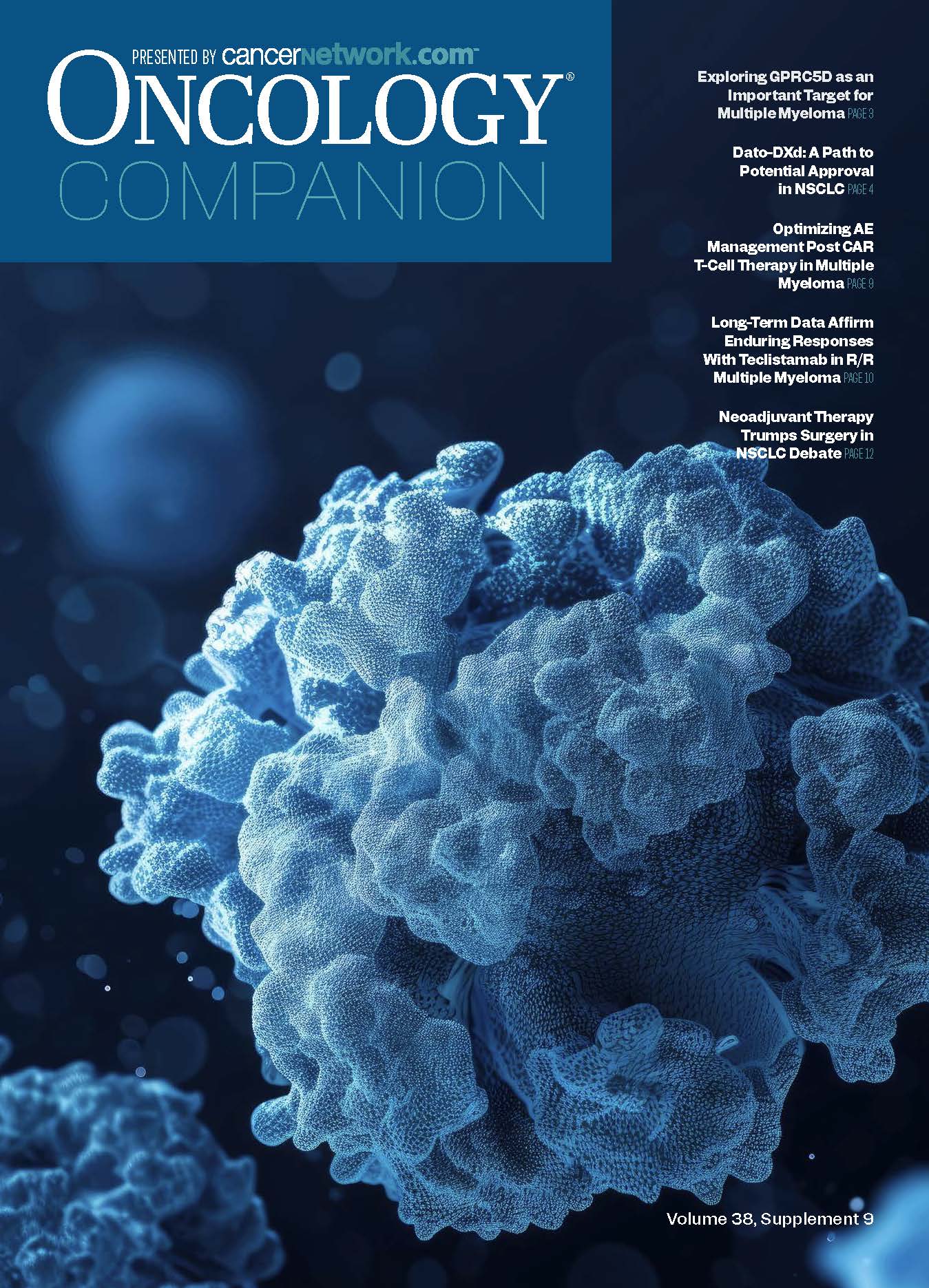Neoadjuvant Therapy Trumps Surgery in NSCLC Debate
The University of Chicago goes against Northwestern Medicine to see who will be crowned the winner in the NSCLC debate.
Meet the experts

During the 2024 American Society of Clinical Oncology (ASCO) Annual Meeting, the stage was set for a contentious debate regarding the current treatment landscape in non–small cell lung cancer (NSCLC). The competitors were 2 of Chicago’s top institutions: The University of Chicago and Northwestern Medicine.
The teams convened for a 3-round event, going back and forth through grueling questions to try to take home the trophy. During the discussion, the panelists touched on recent updates from the conference, presented a series of patient cases, and competed in a head-to-head match on whether neoadjuvant therapy will replace surgery. Read on to find out who was crowned the winner.
Round 1 Data Presentation
Team Chicago and the CROWN Trial
Presented by Faith Abodunrin, MD
The phase 3 CROWN trial (NCT03052608) assessed lorlatinib (Lorbrena) at 100 mg (n = 149) once daily vs crizotinib (Xalkori) at 250 mg twice daily (n = 147).1
Topline data include a median progression-free survival (PFS) not reached (NR; 95% CI, 64.2-NR) at a median follow-up of 60.2 months in the lorlatinib arm and 9.1 months (95% CI, 7.4-10.9) in the crizotinib arm (HR, 0.19; 95% CI, 0.13-0.27). The PFS continued to be NR with and without the presence of baseline metastases.
In the lorlatinib arm, grade 3/4 adverse effects (AEs) occurred in 77% of patients and serious AEs in 44%. The most common included hypertriglyceridemia (25%), weight increase (23%), hypercholesterolemia (21%), and hypertension (12%). Additionally, central nervous system (CNS) AEs occurred in 42% of patients.
Gupta / My only thought and question is, historically, we may have presented alectinib [Alecensa] as a first-line option then lorlatinib as a second-line option if they [experienced progression], but that comparison hasn’t occurred yet. If I give lorlatinib and [the patient has] a 60-month PFS, then what do I do? Is it just chemotherapy? There was some comfort in having 2 tyrosine kinase inhibitor [TKI] options available for a patient in that sequence vs now maybe 1 TKI option and chemotherapy. I wish I could add up the alectinib/lorlatinib duration of disease control vs lorlatinib [in the] front line and then be able to make a decision.
Abodunrin / If my patient walks up to me, I want to give them the best treatment up front. I’m not going to give them something inferior. I want to give them a fair chance.
Herbst / What’s different in 5 years than what we [observed in] 3 years? Toxicity-wise, this hasn’t been compared with alectinib. Is that something that should be done?
Abodunrin / It’s something that could be done down the road. I don’t anticipate that the toxicity differences will be that significant. What we are finding in the clinic and going forward with toxicities is that we might have to start using some [additional treatments]. For instance, semaglutide [Ozempic] might be something that might come into play with the weight gain that we see with lorlatinib. It will mean that we would have to think deeply about how to control the toxicities.
Patel / I don’t want my patients ending up looking like that, gaining 30 pounds and looking like they’re confused and have had mental slowing for 5 years because of lorlatinib. It is not the easiest drug. You take 8 pills a day. At least with alectinib, we know that we can move around. [With lorlatinib, if] you go on vacation, you [need to] bring your drugs with you. Yes, lorlatinib might have some ease of dosing, but then you might have to take your semaglutide and some sort of mood stabilizer.
Team Northwestern and the CHRYSALIS-2 Trial
Presented by Divya Myadam Gupta, MD
The focus of this presentation was cohort C of the phase 1 CHRYSALIS-2 trial (NCT04077463).2 The cohort assessed amivantamab (Rybrevant) plus lazertinib in patients with atypical EGFR mutations who were treatment naive or had 2 or more prior lines of therapy. The recommended phase 2 dose was 1050 mg of amivantamab intravenously or 1400 [mg] if [patients have a weight of] 80 kg or more plus 240 mg of oral lazertinib.
The median follow-up was 16.1 months, and the overall response rate was 52% (95% CI, 42%-62%). The median duration of response was 14.1 months (95% CI, 9.5-26.2). Additionally, 52% of patients had a partial response, 35% had stable disease, and 8% had progressive disease. The clinical benefit rate was 79% (95% CI, 70%-86%).
The median PFS was 11.1 months (95% CI, 7.8-17.8). The median overall survival was not evaluable (NE; 95% CI, 22.8-NE).
Safety was consistent with previously reported results. The most common grade 3 or higher AEs were rash (13%), hypoalbuminemia (8%), paronychia (5%), and infusion-related reaction (4%).
Thawani / Our cancer center has the resources for amivantamab. We’d never even used amivantamab [in the] front line. Why do you think we’ll use it in the front line now that we have another frontline option possibly?
Gupta / Even though our institution has many resources, it has been challenging to administer amivantamab. Despite the resources, it speaks to the drug, not the institution. The drug is difficult. The time toxicity with regard to day 1, day 2, and weekly visits for 4 weeks followed by biweekly visits is a lot to ask for patients. I agree with you. I’m also torn on giving this [in the] front line when we have a pill option that’s easy to administer and easy to monitor toxicities for. We’re all comfortable managing toxicities as well. Amivantamab may be an answer to some of these questions that we have.
Round 2 Patients Cases
Team Northwestern on EGFR-Mutated Disease Post Osimertinib
Presented by Jyoti D. Patel, MD
Patient case 1

The University of Chicago had no challenging questions for Northwestern Medicine.
Team Chicago on KRAS G12C NSCLC
Presented by Robert Cameron, MD, PhD
Patient case 2

Patient case 2 continued

Sabari / This patient had 3 different courses of radiation from 2014 to 2024. What is the role of radiation in the metastatic setting?
Patel / In these patients [with mutations], we’re [starting to see] this slower progression.
Gharzai / We can use radiation to reduce and slow things down. Radiation is incredibly safe to give multiple courses of, especially to the brain or even other sites of disease. We know how to reradiate safely as well. It’s very much a thing that we can continue to do and safely deliver throughout a patient’s course [of treatment].
Sabari / This patient [had] significant benefits, but most of our patients do not. Where do we need to go?
Patel / We have 2 approved KRAS inhibitors, and both have weaknesses such as CNS penetration, gastrointestinal toxicity, and the inability to combine one of them with immunotherapy. There are a number of exciting KRAS inhibitors on the horizon that are easier to combine. This patient’s been on [a KRAS inhibitor] for a long time; it’s nice that you’ve seen continued CNS response. That’s exciting. This pivoting of the difficulty in combination strategies with the available TKIs is a hurdle right now.
Round 3 Hot Topics
Team Northwestern on Whether Neoadjuvant Therapy Will Replace Surgery
Presented by Jyoti D. Patel, MD
Patel / It’s 2024; let’s look at the data. Clearly, neoadjuvant therapy is superior for NSCLC. We know that it’s less time [on treatment] for patients. You think about how patients spend their lives with resectable disease. This gives us an opportunity for an in vivo assessment of what we’re doing. We know that this leads to more cures, and certainly, it’s a [much] cheaper strategy.
It hits 4 things that most of us prioritize. In terms of time, don’t mess with my time; that’s my most valuable resource. Give that back to your patients, stop taking it from them. [For] this idea of an in vivo assessment, isn’t it great for us to see what we’re doing rather than leading the blind? Take that out, and let’s just give it 1 year or 2 [years] for adjuvant therapy. Let’s at least use what we know. Do these drugs work? Perhaps the radiographic as well as pathological assessment will inform our decisions.
It’s 2024; we don’t need to be needlessly following dogma. We know it also leads to more cures. We know that pathologic response improves survival. An interesting study several years ago was done in melanoma, and we saw another one in the plenary [session at ASCO] this year [with findings] that show that giving induction therapy improves outcomes.3 We can tailor adjuvant therapy. The antigen is intact; we can develop an army of white blood cells that have memory and keep you clear forever. Do we need to spend our money, time, and effort doing these complicated trials in which we’re [randomly assigning] patients up front or later?
Are we going to have to wait until 2035 to get the answers to our current cooperative group strategy? No. Let’s move on. This is a definitive yes. Patients will have ongoing toxicity with a year of therapy. We know the efficacy is better. Curing more patients, we’ve seen that from the melanoma literature, and it’s certainly a savings to move to discreet neoadjuvant therapy.
Thawani / I got the short end of the stick, clearly. How will I make my case right now? I’m going to make a losing argument, so we’ll see how that goes. Adjuvant targeted therapy cannot be replaced for patients with EGFR mutations. You’re still going to use adjuvant therapy. Neoadjuvant therapy is not the same as perioperative therapy, which you will probably still use in some patients.
If you have a 69-year-old patient with lung cancer with T3N0 disease, what do you think the patient’s going to be cured of? Would you give this patient the CheckMate 816 [NCT02998528] regimen if the patient has PD-L1–negative disease? Now you may say maybe, maybe not. Would you still give the CheckMate 816 [regimen] if the patient has an oncogene? Probably not. And if you do give this patient chemoimmunotherapy, we know that 1 of 5 to 6 patients will probably not make it to surgery. Why would you do that? I don’t know. These patients are probably not going to [have] curable [disease] anymore if they [develop] progression or pneumonitis while receiving chemoradiotherapy [CRT]. If they get pneumonitis, they’re probably not getting CRT or surgery.
The other argument I make is that the control arm of CheckMate 816 was wrong. A patient [with] T3N0 [disease] back in the day before CheckMate 816 got neoadjuvant chemotherapy, or would they just get surgery? If someone had surgery, then surgeons do think that they take things out, and [with] T3N0 [disease], they probably can take it out. Then you can give adjuvant chemotherapy and immunotherapy, and you know you have the option of stopping at that point, and then they’re probably still considered cured. This probably should have been the control for CheckMate 816.
The other argument is the case for perioperative therapy. Are 4 cycles enough? Would you give 4 cycles if someone was just getting adjuvant therapy? Probably not. Would you still stop at 4 cycles if there were no [response]? I don’t know. I still use neoadjuvant therapy, so I’m just going to be a devil’s advocate because I want to win this debate. It’ll make me famous at the University of Chicago if I win a debate against Dr Patel.
And the winner is...

